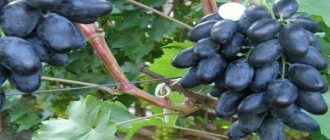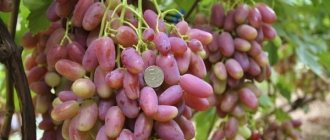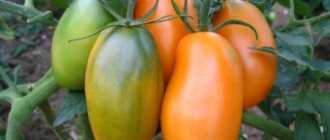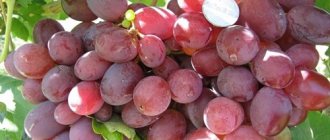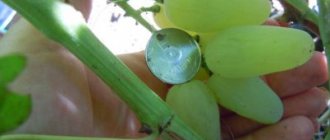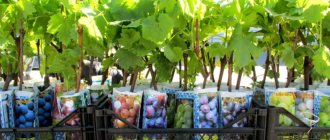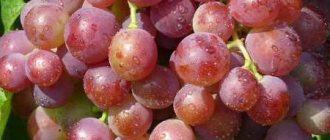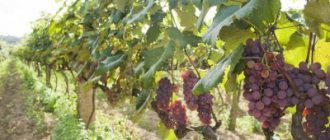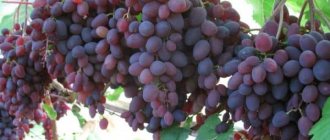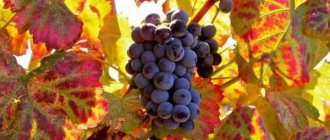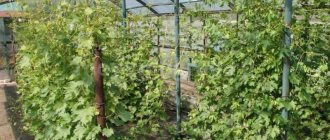Aleshenkin grapes are one of the many dessert grape varieties. It was developed in Russia in the mid-20th century. The plant is distinguished by the fact that it has an average ripening period. The fruits can be collected, as a rule, in the last ten days of August. At the same time, the variety is very resistant to excessive frost. Which makes it quite advantageous compared to many other plants. Gardeners also appreciate this variety because it has excellent taste characteristics, and the grape bunches are very large, aesthetically attractive, and have an ideal marketable appearance.
The Aleshenkin grape variety is excellent for growing in various regions of Russia. Before planting, it is best to carefully read the description of this variety, identify its characteristic features and characteristics, and understand whether this variety is suitable specifically for this gardener. We will begin, of course, with a description of the Aleshenkin grape variety, as well as with its main characteristics, which largely determine this variety.
Aleshenkin grapes: variety description and characteristics
Grapes Aleshenkin: photo of the variety
If we delve deeper into the description of the Aleshenkin grape variety, we can highlight several characteristic features:
- The bush is tall. The leaves have a standard shape for grapes. They are distinguished by a rich emerald color. The leaf size is medium;
- leaves are smooth. Their surface is glossy;
- Bisexual flowers can form on each shoot. Therefore, the bush does not need additional plants nearby for pollination;
- Grape cuttings adapt very quickly to new conditions. They take root and take root in soils of varying composition;
- one branch can carry out its life activity in a period of 4 to 6 years. Much depends, of course, on the care and attention of the gardener. And also from care measures.
Description of the plant and specifics of cultivation
The vine has great vigor, with well-ripening shoots. The perennial parts of the bush are covered with reddish, coarse-fibrous bark. The leaves are simple, medium-sized, five-lobed, medium-dissected, dark or light green, smooth, shiny, without pubescence. The petiole recess is closed, with a rounded lumen and a pointed bottom. The teeth along the edge of the leaf are triangular, large, with a wide base and rounded tops. The flowers are greenish, small (3-5 mm in diameter), bisexual. For the full formation of ovaries, the variety does not need to select additional pollinators.
Bushes are fast-growing, densely leafy
Fruitful shoots range from 55 to 75%, on average the load on each is 1.1-1.3 bunches. Shoots that are too thin and grow from the head of the bush are not allowed to bear fruit. To obtain a stable and high-quality harvest, experts recommend medium pruning of fruit shoots (6-8 buds).
Aleshnkin grapes: features of the variety
Grapes Aleshenkin: photo of the variety
Aleshenkin grapes are classified as dessert varieties. It has not only external attractive properties. And also excellent taste characteristics. The bunch in the shape of a regular cone is strewn with berries. They don't fit very tightly together. Thanks to this, each berry can receive a sufficient amount of sunlight. And this is a huge advantage.
The weight of one bunch can reach more than 2 kilograms. This is not the limit if the gardener properly cares for the plant. He also chose the right agricultural tactics. Oval shaped berries. The weight of one can usually reach 5 grams. The pulp is very juicy and fresh. And the skin is not too thick. Moreover, the berries contain up to 20% sugar. Seeds are found in only 60% of the crop. A gardener can remove up to 25 kg of grapes from one vine. And this is actually an excellent indicator.
Comparison with analogues
Below is a table showing a comparison of the “Aleshenkin” variety with other early ripening white grape varieties.
| Sign | Variety | |||
| Aleshenkin | Bazhena | Laura (Flora) | Timur | |
| Ripening period | 100 – 120 days | 105 – 115 days | 110 – 115 days | 105 – 115 days |
| Frost resistance | -25C | -24С | -23C | -25C |
| Productivity | Up to 25 kg | 25 – 30 kg | 30 – 35 kg | 6 – 10 kg |
| Bunches | From 300 g to 1.5 kg | 700g – 1.5 kg | 600 g – 1 kg | 400 – 600 g |
| Taste | Harmonious, sweet with notes of nutmeg | Fruity notes | Pleasant, harmonious | Pleasant, with light notes of nutmeg |
| Color | Amber yellow | Lime-amber | Lime white | White-amber |
| Disease resistance | Below average | Average | Above average | Above average |
| Shelf life | 1 month | 1 – 2 months | Up to 2 months | 1 month |
| Sugar accumulation | 17 – 20% | 15 – 16% | 20% | 17 – 22% |
| Acidity | 3 – 6 g/l | 4 – 6 g/l | 5 – 8 g/l | 6 – 9 g/l |
Disadvantages of the variety
Grapes Aleshenkin: photo of the variety
If we talk about the disadvantages of the Aleshenkin grape variety, then among them we should highlight the fact that the lower part of the plant practically cannot withstand freezing. Therefore, it needs additional protection. To protect the lower part, it is enough to graft the variety with more resistant rootstocks.
But as for the ground part, it is more stable. As a rule, it can withstand temperatures down to -26 degrees. And at the same time it does not react at all to such a decrease in temperatures in a negative way. Which is indeed a very good result.
History of growing the variety
This grape has an unusual name - Alyoshenkin. The famous Soviet scientist, breeder, academician, front-line soldier Pyotr Efimovich Tsekhmistrenko named it in honor of his grandson. This variety is also called Alyosha, or quite prosaically - No. 328.
The variety is included in the State Register of the Russian Federation under the name Alyoshenkin Dar (code 9553098). Such a variety of names sometimes causes disputes between gardeners as to whether they are talking about the same variety.
Pyotr Efimovich is the author of one and a half dozen varieties of fruit trees, and in 1956, these grapes came out of his hands, the result of more than twenty years of work. Academician Tsekhmistrenko lived and worked in Volgograd, where it is hot in the summer, but the winters there are harsh. Therefore, the variety bred in these southern regions is able to tolerate frost down to -26 °C.
Aleshenkin grapes: advantages of growing
Grapes Aleshenkin: photo of the variety
The yield of the Aleshenkin grape variety is as high as possible. The fruiting period is usually about 6 years. Practice shows that within 20 years you can collect special sweet fruits from one grape bush. But this can only be achieved if the gardener gives the plant enough attention and care.
After this, fruiting may suddenly decrease or disappear altogether. This will indicate that the plant is old. And it must be removed from the site. Afterwards, it is necessary to wait, as a rule, about 3 years to begin growing new grape bushes in the same area.
During this time, the soil is completely restored. Saturated with beneficial mineral components. It also becomes again suitable for growing grapes. If you completely replace the soil on the site, then within a year you can plant new grape bushes.
Yield indicators
"Aleshenkin" is a high-yielding variety. Its fruiting period is 6 years. As practice shows, sweet berries are collected from the bush for 20 years.
Then the fruiting of the grapes sharply decreases, and the plant is removed from the site. The next planting of grapes is carried out no earlier than after 3 years. During this period, the soil is restored.
If it is possible to completely replace the soil, then it is allowed to plant grapes after a year.
Planting and caring for the Aleshenkin grape variety
Grapes Aleshenkin: photo of the variety
Of course, like any plant, the Aleshenkin grape variety requires that the gardener follow the planting rules. As well as plant care. After planting, the plant needs regular watering. And also in pruning. An important step is to treat the plant against various pests and fungi. And also viral diseases.
A well-lit, warm place is ideal for planting. The Aleshenkin grape is a variety that, in principle, does not make any claims regarding the composition of the soil. If the gardener follows agrotechnical rules, he will be able to get a very rich harvest. Even in not the most suitable climatic conditions. Or at the wrong time for fruiting.
Productivity
Alyoshenka is ideal for lovers of early grape varieties. It is high-yielding, yielding more than twenty-five kilograms per bush. In field conditions, without fertilizing, it brings up to ten kilograms of harvest.
Has increased frost resistance. Fruits can remain on the bushes for a long time, up to minus 26 degrees Celsius.
But experienced winegrowers graft the variety for frost resistance. For the winter, grape bushes must be well covered with spruce branches or plastic film with good air supply.
Choosing a landing site
In order for the Aleshenkin grape to grow well, the soil should be prepared either in the fall or in the spring. The gardener first analyzes the composition of the soil. If it contains an excessive amount of clay, a drainage pad should be prepared.
If the gardener decides to develop a vineyard on peat soil, then the soil should be mixed with sand before planting. Sandy soil responds very well to organic fertilizing. It is best to choose humus or compost as organic matter.
It is best not to plant this grape variety in swampy areas. Because the vine is too susceptible and may die.
Methods of propagation of grapes
The Aleshenkin variety is characterized by propagation by cuttings and offshoots (vines), as they quickly ripen and take root. Experts recommend planting with cuttings, which are harvested after pruning in the fall or spring. Autumn cuttings are wrapped in boxes and stored in a cool place until spring.
Before pruning grape cuttings, you need to water them thoroughly 2-3 days before. Choose a vine with a thickness of 7-10 mm; a smaller size will take root less well. Spring cuttings can be immediately planted in a greenhouse, greenhouse or open ground. Before planting, you need to treat it with a growth or root formation stimulator and plant it at an angle of 40-50 degrees in soil saturated with fertilizers.
Preparing for landing
About 10-14 days before the bush is planted in open ground, it is necessary to dig up the soil. This is done in order to enrich the soil with oxygen. It is best to choose a location that will be located in the south. Or in the southwest on the site. Because there the soil will warm up best.
To protect Aleshenkin grapes from windy weather, as well as from destructive drafts, it is necessary to plant grapes near the wall of the house. Because there he will feel as comfortable as possible. In spring, precipitation will fall faster from the south side. And in the fall, when the soil begins to freeze, on the south side it will freeze much more slowly.
It is best not to plant Aleshenkin grapes between various shrubs or trees. Because they can create unwanted shadows. It will only have a negative effect on the grapes of this variety. The variety is also excellent for growing in greenhouse conditions.
Aleshenkin grapes really need sunlight. Since if the plant is kept in conditions where moisture accumulates, this will only have a detrimental effect on the general condition of the plant. And also on the development of its root system.
Features of care
To get a high-quality harvest, you need to properly care for the grapes. No matter what anyone says, any variety, even such an unpretentious one as “Aleshenkin,” loves to be watered, fertilized, and pruned. Therefore, in order to grow large, tasty and marketable bunches, you must follow a number of rules:
- As mentioned above, the grape bush grows well. This applies not only to shoots, but also to the root system. However, it is worth noting that the surface part of the plant does not tolerate frost. Therefore, in order to protect Aleshenkin from frostbite, it is best to graft it onto frost-resistant varieties.
- The seedlings need to be planted in the spring, immediately after the end of frost. It is advisable to plant the plant in the soil in which it previously grew. Before transferring the seedling with a lump of earth into the hole, it is watered abundantly and fertilized with peat. In the first 3-4 days after planting, it is necessary to water the plant abundantly. Then the number of waterings is reduced.
- The variety itself is unpretentious. And even if there was rain in the summer and there was no care, you can still expect a good harvest. However, in winter you will have to take care. The grapes can withstand low temperatures, but not strong ones. Therefore, you still have to cover it.
- One-time, it is necessary to carry out the pruning procedure. Every year you need to analyze the shoots and identify (if any) weak vines that do not produce a normal harvest. This will increase productivity by normalizing the load.
- Also, in addition to pruning weak vines, you need to normalize strong shoots. They are cut in two ways: with 10 eyes and with 6 eyes. One bush can easily withstand up to 50 buds.
- The variety has good immunity, but, as in most cases, it applies to some specific diseases. He is powerless in front of others. Therefore, to protect the plant, it is necessary to treat it with special means.
Aleshenkin grapes: variety care
Grapes Aleshenkin: photo of the variety
Planting and caring for the Aleshenkin grape variety begins in the spring. Then, in summer and autumn, the plant takes root and adapts. And only after this can it endure the winter. Even if it is harsh. And temperatures will not be so stable.
In the fall, the gardener must dig up the soil in the selected area. A hole is dug, the width of which is 60-70 cm, and the depth should be up to 1 m. If the gardener knows that groundwater is located close to the surface, then it is necessary to arrange homemade drainage. For this purpose, crushed brick, crushed stone or expanded clay are usually used. They can be purchased at construction or gardening stores.
In the spring, the gardener prepares fertilizer for Aleshenkin grape seedlings. To do this, he mixes soil and collected river sand in equal proportions. And also rotted humus. Then a certain amount of nitrophoska and superphosphate must be added to this mixture. Because they perfectly enrich the soil mixture. And they can have a positive effect on the plant, its growth and development. And also taking root in completely new conditions. Before planting, the hole should be filled with warm, settled water.
Growing and further care
Proper care of Aleshenkin grapes is the key to obtaining a rich harvest. The growing process involves performing a number of activities taking into account the phases of plant growth.
Watering and fertilizing
After planting, plants need abundant watering. Each bush requires 20 liters of water. Watering is carried out once a week throughout the entire month from the moment of planting. From the second month, moisture is added once every 2 weeks, from the third to the end of the year - once a month. Weather conditions are also taken into account. If there is sufficient rainfall, watering is not carried out.
Read how to properly feed grapes in the fall.
Adult bushes are watered only during periods of drought, in the spring before flowering and in the fall after harvesting. This watering schedule is optimal for grapes of this variety. With high humidity, there is a tendency for fungal diseases and pests to spread.
Fertilizer application is combined with watering. They begin to apply them from the second year of plant life on the site. At the initial phase of the growing season (spring), plants need nitrogen to form healthy green mass. To do this, the soil is fertilized during spring watering with 40 g of urea per 10 liters of water for each bush.
You can also use organic fertilizers, for example, chicken droppings: add 100 g of droppings to 10 liters of water. Before flowering, potassium salts are added at 5 g per bush and 20 g of superphosphate. After flowering, the soil is fed with compost - 5 kg per bush. It can be applied in liquid form, diluted in 5 liters of water, or buried to a depth of 5 cm in the soil. After harvesting, add potassium salt 5 g per bush and dolomite flour 40 g per bush.
Pruning and shaping the bush
Pruning is carried out in autumn and spring. The procedure involves removing branches that no longer bear fruit and shortening overgrown shoots, which can significantly increase yield. From 3 to 9 eyes are left on the shoots, depending on the size of the area and the age of the plants.
Read more about proper pruning of grapes in spring.
The formation of fruit buds occurs annually, but during formative pruning, no more than 1 inflorescence is left on the shoots. In total, 35–40 inflorescences remain on the bush. This allows you to reduce the risk of peas and achieve uniform ripening of the crop. At the stage of berry formation, excess leaves are also removed, which prevent sunlight from reaching the fruit.
Every 5-6 years it is necessary to rejuvenate the bush, since the vines bear fruit only for 5 years. To do this, in the spring, choose the strongest young shoot and leave up to 9 eyes on it. When the new sleeve is formed, the old one is cut down with a hacksaw to create a stump. After pruning, each cut is treated with garden varnish.
Mulching the soil
After watering, rain and fertilization, the soil around the trunk is loosened, simultaneously removing weeds, to a depth of 10 cm. Then the soil around the trunk is mulched. Sawdust, straw or humus are suitable for this. This approach allows you to protect the root system from overheating and retain moisture in the soil for a long time. In addition, mulch gradually decomposes and releases nutrients to the soil.
Important! Adding granulated sugar to the mulch (100 g per 10 kg of mulch) will help increase the sugar content of grapes and enrich the soil with calcium.
Reproduction methods
The Aleshenkin grape variety can be propagated in several ways:
- Seed - used only in areas of industrial importance. The hybrid loses its qualities when propagated by seeds, so it will be necessary to graft onto other varieties, which delays the fruiting period.
- Cuttings are the method most often used for home cultivation. The cuttings are cut during the spring pruning period. Suitable planting material must contain at least 4 active buds. The cuttings treated with copper sulfate are rooted in the ground, deepening to 3 cm. Then standard care is carried out.
- Layering is another easy way to get a new plant at home. The long whip is bent and covered with soil. After 4 weeks, when the shoot takes root, it is disconnected from the mother plant, and the cut is treated with garden varnish.
Seasonal care
Knowledge about the characteristics of the plant’s growing season will help you create an optimal schedule for seasonal work with the vineyard in spring and summer:
- In mid-April, active sap flow and awakening of the root system begin - using a fork, lift the vine from under the shelter to ensure air circulation and cover it with dry hay.
- Apply fertilizer to the soil and loosen it.
- At the end of April, remove the covers and leave the lashes until the buds swell.
- When the buds begin to swell, treat with a 1% solution of Bordeaux mixture.
- At the beginning of May, tie last year's shoots and long sleeves to the first and second wires of the trellis, securing them in a horizontal position.
- Loosen the soil in the standard circle to a depth of 5–10 cm, in row spacing - 15–20 cm, then mulch with humus.
- In the phase of budding and the formation of new shoots, carry out rationing when the shoots reach a length of 3–5 cm. Shoots that have blossomed at the base of the trunk and on perennial branches must be removed.
- In early June, tie new growing shoots upright to a trellis.
- Apply fertilizers, loosen and mulch.
- In the flowering phase, shorten the shoots by 3 cm, eliminate excess peduncles and all tendrils.
- During the growth and filling phase of berries, remove the tendrils, apply fertilizer, loosen and mulch the soil.
Shelter for the winter
After harvesting, you need to start preparing the plants for winter. When the fruits are collected, no work is carried out for 1-2 weeks to allow the plants to replenish their supply of nutrients. This is followed by the application of fertilizers, seasonal pruning of the vine, dew roots, which are located at a depth of 5 cm, and water-recharging watering of 50 liters per bush.
After pruning, collect the vine into a sheaf and tie it. Place spruce branches or soft hay on the ground to provide ventilation, and lay the vine on the flooring. Build a temporary shelter over the vine that can be easily removed in the spring, such as a wooden pallet. It is important that there is a distance of 10 cm between the pallet and the vine. Lay a waterproofing material on top of the shelter - tarpaulin or dense polyethylene. Sprinkle the surface of the waterproofing material with dry leaves.
Rules for planting grapes
Grapes Aleshenkin: photo of the variety
If the cutting is located in a container, then it can be planted in open ground without unnecessary preparation. If the plant was previously placed in a bag, then it is necessary to initially lower the cutting into a growth stimulator. A zircon-based solution is best suited for this. Zircon is a biological, natural remedy. It has a very positive effect on plant growth. In addition, the drug is very economical. For 10 liters of water, only 1 ml of the drug is required.
A seedling of the Aleshenkin grape variety must be placed at the bottom of the hole. Then it buries itself, but not completely. But only half. Next, the seedling should be watered very well with settled water. And also pour out the remaining top layer of soil.
Aleshenkin grapes are also covered with polyethylene. And a hole is made on top so that the seedling can breathe. The material can only be removed by the end of summer. When the gardener is sure that the plant is completely rooted. By following these rules of agricultural technology, you can plant a plant. And also have no doubt that it will take root perfectly. And after a while it will give an excellent and very tasty harvest.
Reviews
Egor, 55 years old, Ussuriysk
“Aleshenkin” is a good variety, attractive with its high yield and tasty berries. I consider its main disadvantage to be large clusters. The upper berries ripen first, while the lower ones remain unripe. The inside of the berries often rot if they are not removed in time. One brush is left for two shoots. The ripening of the entire grape vine is then guaranteed. With increased load, the vine does not have time to ripen, and the bush may die.
Alexander, 65 years old, Zelenograd
I have been growing “Aleshenkin” in the country for 10 years. The vineyard tolerates winter well and does not freeze. In the fall I cover it with spruce branches and plastic wrap. The variety gives a stable harvest. If during flowering the weather was rainy and cold, then peas occur. By August 20, the grapes are ripening. Seedlings need 3 years to take root and grow vines. After harvesting, it can get sick, so I definitely treat it with Ridomil.
Anna, 48 years old, Belgorod
I have been growing Aleshenkin grapes for 20 years. This is the first vineyard that appeared on my site. The variety prefers short pruning, so 3-4 eyes are left. Ripening begins at the end of July, the berries taste sweet. I make sure to ration the grapes before and after flowering so as not to overload the vine. I eliminate excess wings and trim too long brushes.
Vinograd Aleshenkin: rules of agricultural technology
Grapes Aleshenkin: photo of the variety
After the cutting has been planted, it must be watered regularly. Watering frequency - no more than once every two weeks. Each plant requires on average about 4 buckets of warm, settled water. If precipitation or excess moisture occurs, it is best to stop watering for a while. To prevent rotting of the root system.
In the spring, the plastic cover is removed from the vineyards. The gardener also removes those branches that are damaged or have become old. Therefore, they will not produce any harvest. The vine must be tied to a trellis so that it does not spread out. And it gave active growth only upwards.
Before the buds begin to bloom, it is necessary to feed the vineyard. For this, it is best to use solutions and liquid fertilizers. Mullein solution is ideal. As well as a solution based on wood ash or superphosphate. In summer, it is best to pinch the vine a little. At a height of approximately 170 cm.
Aleshenkin grape variety - the choice for Russian conditions
A significant part of Russia's territory is located in the zone of risky agriculture. It seems rather ridiculous to talk about growing grapes here. When it is mentioned, the Mediterranean, Transcaucasia and other warm regions come to mind. But there are varieties that can grow in the “wild north”. And there are people who are ready to invest energy, time and soul into this difficult work. We will talk about one of these varieties - Alyoshenkin.
History of growing the variety
This grape has an unusual name - Alyoshenkin. The famous Soviet scientist, breeder, academician, front-line soldier Pyotr Efimovich Tsekhmistrenko named it in honor of his grandson. This variety is also called Alyosha, or quite prosaically - No. 328.
The variety is included in the State Register of the Russian Federation under the name Alyoshenkin Dar (code 9553098). Such a variety of names sometimes causes disputes between gardeners as to whether they are talking about the same variety.
Pyotr Efimovich is the author of one and a half dozen varieties of fruit trees, and in 1956, these grapes came out of his hands, the result of more than twenty years of work. Academician Tsekhmistrenko lived and worked in Volgograd, where it is hot in the summer, but the winters there are harsh. Therefore, the variety bred in these southern regions is able to tolerate frost down to -26 °C.
Description and characteristics of Aleshenkin grapes
Alyoshenkin is a table grape variety. Experts rate its taste quite highly - 7 points . Contains a lot of sugar - 16%. The brushes are large and quite loose. The average weight of a brush is 552 g, but sometimes reaches 1 kg or more. The berries are light green with a pleasant yellowish tint, covered with a waxy coating. The skin is tough but edible. There are few seeds, usually one or two, and 40% of the berries are completely devoid of them.
The crop ripens very quickly, in 110–115 days. Productivity can reach 25 kg per bush under optimal conditions, but usually 8–10 kg. Alyoshenkin has characteristic five-fingered leaves that distinguish it from other varieties. Although grapes are considered frost-resistant, the underground part suffers more from frost, so in winter the bushes must be covered.
There are enthusiasts who manage to get a harvest even beyond the Arctic Circle. But this, of course, is in a greenhouse.
Large bunches of Aleshenkin grapes ripen very early - at the end of July
Video: Aleshenkin grape harvest is ripe
Features of planting and care
This grape variety is considered quite unpretentious in comparison with others, so it is recommended for beginning gardeners and winegrowers. But it is better to follow certain rules when growing it.
Favorite places
Grapes love sunny places, protected from the wind, especially the north . The southern slope is best suited. It warms up first in the spring; water does not stagnate there. Grapes do not like waterlogging; in this case, they can be affected by fungal diseases.
Alyoshenkin has average resistance to diseases, but the thing is saved by the fact that in a temperate climate, pathogens also do not feel very good, so if agricultural practices are followed, the grapes almost do not get sick. It is very good to plant grapes under the protection of walls - a building or a fence that will close it from the wind. In addition, the building, having warmed up in the sun during the day, will warm the plants at night, giving off its heat. But it must be taken into account that rainwater from the roof should not flow onto the plants.
Grapes prefer fertile, light soil. Does not tolerate wetlands and saline lands. He doesn't like acidic soil either - he needs to add lime. It is better to carry out all soil preparation activities in the fall. In the spring, before planting, you should dig up the soil so that it is saturated with oxygen and dries out a little.
Landing rules
It is better to plant grapes in the spring, then by winter they have time to take root well and get stronger. The choice of seedlings must be taken very seriously. Only using high-quality planting material can you achieve good results. It is better to take seedlings with a closed root system, but if it is open, you need to pay attention to the color of the roots - the lighter the better. If possible, you can cut one - the cut should also be light.
If the root inside is dark, the seedling is of poor quality.
A healthy shoot is brown, but light when cut. Leaves, if any, should be smooth. The presence of irregularities on them may indicate that the plants are infested with pests.
It is preferable to buy seedlings with a closed root system
The planting process itself can be divided into several operations:
- We dig a hole. Depth, width and length are approximately the same, about 60 cm.
- We pour drainage into the bottom - expanded clay, broken brick. If there is a possibility of excess moisture in the soil, the drainage layer can be up to 25 cm.
- On top of the drainage we pour earth, sand and humus (or peat) mixed in equal proportions.
- Add 1-2 tablespoons of complex fertilizer and a shovel of ash.
- Thoroughly fill the hole with water.
- We also water the seedling well, then carefully remove it from the pot and place it in the hole.
The seedlings are placed in a prepared hole at an angle to the soil surface and watered abundantly
The seedlings are placed not vertically, but at an angle to the soil surface . This will make it easier to put them away for the winter. For the first few days, the seedlings need to be watered intensively, and then watered once every two weeks - approximately 40 liters for each bush.
Spring and summer care
In the spring, after removing the cover, the vines need to be tied to trellises, and the first fertilizing should be done even before the buds appear. An infusion of chicken manure is suitable for this. It is mixed with water in a ratio of 1:2, left for a week, then the infusion is diluted in a ratio of 1:10. This solution is applied to the plants at the rate of 1 liter per bush. It does not need to be poured directly under the root; it is better to make a circular groove and pour the fertilizer into it.
To improve the taste of berries, it is useful to apply potassium fertilizers. The most accessible is ash. It is applied either in dry form at the rate of 1 bucket per plant, or in the form of an extract (fill with water and leave for 3 days).
The very first fertilizing can be done even before the snow melts by scattering granulated superphosphate at the rate of 40 g per square meter.
When the bushes reach a height of 1.7 meters, you need to pinch the tops. Leaves that shade the inflorescences are removed. In case of a dry summer, a circular groove should be made around each bush so that the water does not spread out when watering and goes directly to the roots. In case of high humidity, especially on heavy, clay soil, you need to dig drainage ditches to avoid fungus damage.
Bush formation
The growth of the bush must be controlled. It should not be allowed to grow too much, as this will make it difficult to maintain and reduce productivity. There are many ways to form a bush. Gardeners with no experience in growing grapes may benefit from the pruning system created by winegrower Guyot in the mid-19th century.
- In the autumn of the first year, the young shoot is cut short, leaving two eyes above the soil surface or from the grafting site.
- In the fall of next year, one of the resulting shoots is cut short, leaving two eyes (replacement knot), and the second is longer, from 4 eyes. This will be a fruit vine.
- Next autumn (3rd year), the fruiting vine with all its shoots is cut out, and a new replacement knot and a new fruiting vine are formed from the shoots that grew on the replacement knot.
In areas with temperate and cool climates, fan-shaped bush formations are popular. In this case, for the first two years, pruning is done in the same way as with the Guyot method, and in the third year, 3-4 strong shoots with a thickness of at least 6 mm are selected from the bush, each is cut to a length of at least 50 cm and fan-tied to the bottom wire of the trellis. Moreover, the shoots located on the sides are made longer, and those located in the center are made shorter. In this way, several “sleeves” or “fruit links” are formed.
The vine usually bears fruit for 6 years, then it becomes too thick and difficult to put in a trench for wintering. Therefore, the old “sleeves” are cut down, replacing them with young shoots.
Pruning grapes is a very important agrotechnical activity.
Laying down for the winter
For successful wintering of grapes, the vines are removed from the trellis, tied, bent to the ground, pinned and covered with moisture-proof material. This should be done in dry weather so that excess moisture does not get into the shelter. The optimal time for wintering is from mid-October to mid-November. The average daily temperature should be around 0 °C. If it is too warm, a “greenhouse” will be created under the film, which will damage the vine. The film is sprinkled with earth and mulched on top.
It is very good if in winter there is a lot of snow in the area where the grapes winter. To do this, you can carry out snow retention using improvised means.
In spring, the mulch is removed after the snow melts, and the film is removed a little later, when the plants begin to grow. At the same time, if the covering material allows light to pass through, it is necessary to ensure air access to the shelter.
Pest and disease control
The problems with this variety are the same as with others. The most dangerous and common fungal diseases are oidium and mildew. Among the pests, the most dangerous are spider mites, marbled beetles, and biennial leaf rollers. Both chemical and agrotechnical methods are used against them.
Table: diseases, pests and control agents
| Disease, pest | Nature of the lesion | Means of struggle |
| Mildew (downy mildew) | The most common disease. It affects all parts of the plant, yellow spots appear on them, and a white coating appears on the underside of the leaves. Then the affected parts turn brown and die. | Effective:
|
- When the shoots reach a length of 15–20 cm.
- Before flowering.
- When the berries reach the size of a pea.
To prevent diseases, it is important to prevent thickening of the bushes and promptly remove excess shoots. This ensures good ventilation and maintains normal humidity. It is very important to utilize plant residues and not interfere with the development of weeds, especially in the spring, when they become a food source for overwintered pests.
Aleshenkin grapes and care for them
Grapes Aleshenkin: photo of the variety
If some inflorescences are in the shade due to leaves, then it is also best to remove excess leaves. This procedure will not harm the plant in any way. But he will only open the flowers. And they will be more saturated with the necessary sunlight.
Flowers of the Aleshenkin grape variety have both sexes. And they rarely need additional outside pollination. If the grapes do not have enough pollination, then you may notice grape peas. The berries become very small. Some may lose their taste. And some, on the contrary, become even tastier. One way or another, to avoid this, it is necessary to use biological growth stimulants. They are usually intended for fruit and berry crops.
Next, you don’t need to feed the Aleshenkin grapes at all. If precipitation is observed, then after its completion the soil should be thoroughly loosened. Watering is also resumed around October. In this way, the gardener can better prepare the soil for wintering. And, accordingly, the plant itself will be ready.
What type does it belong to?
Table grape variety No. 328 is affectionately called Alyosha or Alyosha by winegrowers.
The original name was Aleshenkin's Gift. Refers to artificially bred varieties.
It is an early ripening variety, from 110 to 118 days of ripening, at temperatures above 20 degrees Celsius.
The variety is vigorous. Polarity is highly developed.
Aleshenka's leaves are dark green in color, medium in size, five-lobed with a characteristic shine.
The petiole notch is round and closed in shape.
The lateral teeth are serrated, and the ends of the blades are triangular. The main vein is longer than the petiole.
The berries have a good presentation.
When the bushes are overloaded with fruits, severe peas are observed.
Vigorous grape varieties are found quite often, you can find some of them on our website. Read the descriptions: Ataman Pavlyuk, Anthony the Great, Anyuta, Amethyst.
Bush formation
Forming allows you to increase the level of yield. And also eliminate branches that are outdated and withered. And they will no longer be able to bear fruit. But they can lead to thickening of the crown. And this, as a rule, increases the risk of developing various diseases. What any gardeners try to avoid.
The Aleshenkin grape variety tolerates autumn pruning best. And its sleeves are placed in trenches and protected from the cold. When pruning, it is best to leave about 16 healthy buds and remove the rest. If the gardener is forming a very young plant, then it is better to leave no more than 4 shoots on each branch.
On the branches from which last year's harvest was harvested, 3 buds are left. The peculiarity of the variety is that full-fledged inflorescences can also form on the lower bud. And this is a huge plus. Although it has its own care. As well as measures to prepare for the winter period.
Description of bushes:
Among the vegetative properties of grapes “No. 328”, the ability for enhanced growth stands out. There is always a lot of greenery on the bushes. The leaves of the plant are not large, dark with a smooth shiny surface. “Alyosha” differs from other grape varieties in its five-pointed leaf shape. They are perfect for housewives for making cabbage rolls.
The variety is prone to harvest overload, so rationing of shoots and tassels is required. Two clusters are formed on the vines in the area of the third and fourth leaves.
The normal load on one bush is 35 - 45 eyes. Pruning of the Aleshenkin Dar grapes is done long by 8 and 10 buds, as well as medium (no more than 6 buds).
In general, the growth force of the root is very strong. The vine is capable of producing fruitful shoots from the root. The chubuks of this variety take root well and take root quickly. Old wood can bear fruit effectively for up to six years, then the sleeves need to be replaced with younger wood.
Vinograd Aleshenkin: disease prevention
Grapes Aleshenkin: photo of the variety
The Aleshenkin grape variety requires regular preventive treatments. Moreover, both from diseases and from attacks from pests. To reduce the risk or completely prevent fungal diseases, it is recommended to treat the bush with growth stimulants. And also use a lime-based solution.
The variety is distinguished by the fact that it is very susceptible to diseases such as oidium. Therefore, it is necessary to treat the bush at least once with a preparation called “Topaz”. To protect Aleshenkin grapes from mildew, another product is used - Ridomil Gold.
Diseases and their prevention
The variety is susceptible to fungal diseases . Alyoshenka is prone to peas and fruits being eaten by pests. Therefore, preventive treatment of grapes with various growth stimulants is recommended. Frequent spraying is required. Experienced winegrowers spray the bushes with lime .
The most dangerous pests for Alyoshenka are spider mites and marbled beetles.
The tick is very small and difficult to notice with the naked eye. It reaches no more than 0.5 millimeters in size. The body is almost transparent, with a white-yellowish tint.
It lives on the underside of leaves. Its main food is the sap of the plant.
The tick tolerates frosts well even without snow cover, down to minus 30 degrees Celsius.
Marbled Khrushchev is widespread throughout the CIS. It has a multi-year development cycle. The larvae feed on grapevine roots and humus.
Khrushchev chews through the roots of the plant, which leads to its death. Both young and old bushes are prone to being eaten by the marbled beetle.
A harmless but also undesirable pest is the biennial leaf roller , which lives in the Central Asian republics and Ukraine. You can get rid of pests using treatments.
The grapes do not tolerate shade and excess moisture.
Alyoshenka is weakly resistant to mildew and oidium . Both of these diseases are destructive to the variety and can destroy the fruit in a few days. When grapes become seriously infected, the bush loses all the leaves and fruits of the current year, the shoots begin to ripen poorly and the plant has poor winter hardiness.
The most favorable condition for downy and powdery mildew is considered to be hot weather above 30 degrees Celsius, with high air humidity. That is why the Aleshenka variety is a favorite of northerners, growing painlessly and safely in the northern part of the country.
If diseases are detected on the bush, it is necessary to urgently carry out treatment. Well-proven drugs in the fight against these diseases are Stroviy and Efal.
In addition to the diseases listed above, grapes are also susceptible to such types as bacterial cancer, anthracnose, chlorosis, bacteriosis, various types of rot, and rubella. Familiarize yourself with their signs in special materials and you will know how to prevent diseases from appearing on plants.
The variety requires root or foliar feeding . Tolerates mineral and organic fertilizers well. You can fertilize Alyoshenka with superphosphates, manure, potassium salt and compost. But wood ash brings greater effect. Liquid fertilizers are most easily absorbed.
Pest Control
Spider mites are one of the pests that can be very dangerous for grapes. To prevent its attacks, the plant must be treated with phosphamide or nitrafen in the fall and spring. The bushes must also be regularly inspected for various deformations. The root system can be attacked by marbled beetle. You can get rid of it if you inject hexachlorane directly into the soil.
Distinctive characteristics
You can distinguish the variety from other varieties of grapes by the following characteristics:
- the leaves are small, smooth, with carved edges, their color is rich green;
- clusters in the form of a cone are formed in large sizes, weighing about 650 g;
- oval berries are loosely arranged in a bunch of grapes, each of them weighs up to 6 g;
- almost half of the berries have no seeds inside.
The pulp of the berries is loose, very sweet and juicy. The sugar content of the variety reaches 19%. Various drinks are made from them.
Reviews from those who planted
Igor
“I grew grapes for the first time and, as it seemed to me, I tried to do everything to the maximum to preserve the bush. Of course, I didn’t even want to hear about pruning, and even for knots. As a result, the entire harvest resembles peas rather than grapes. Later I read that all those branches that gave a harvest must be cut off. This will only benefit the bush, and the fruit will be larger.”
Olga
“The grapes rotted on the plot several seasons ago. I searched for a reason for a long time. And only then did I pay attention to the frequency of watering. I watered it 2 times a week, still afraid that the variety would dry out. As a result, I got wet. This season I water the bushes no more than 4 times a month.”
The grapes, despite all the difficulty in caring for them, are unpretentious. With proper care, it will not only delight you with its harvest, but will also help transform part of your garden plot without additional costs.
Reviews from winegrowers
Feedback from experienced gardeners will help you determine the strengths and weaknesses of grapes.
Pavel, Yeisk: “I planted the Aleshenkin variety 10 years ago. The bushes grew quickly, there were no problems with cuttings. I harvest at the end of July and am always pleased with the results. The berries are large, amber-green, the pulp is very juicy and sweet. The whole family loves to eat grapes. During cultivation, the bushes never got sick.”
Ekaterina, Moscow region: “I love grapes, I decided to try the Aleshenkin variety. The yield is average; last season I harvested 15 kg. The taste of the berries is not bad, the pulp is pleasant. She dried some of the harvest, and ate some with the children. I rate the variety a solid “4”.
Polina, Temryuk: “The Aleshenkin variety disappointed me - the cuttings did not take root well. I followed all the recommendations, but I couldn’t grow large berries. The bushes are weak, the fruits are small. Sweetish to taste, but not enough. I think it’s a matter of unsuitable soil.”
Advantages and disadvantages
The main advantages of the Aleshenkin variety include:
- numerous yields;
- early ripening of berries under any conditions;
- pleasant taste and no seeds;
- The variety quickly adapts after planting.
The Aleshenkin grape variety also has weaknesses:
- The roots of the grapes do not tolerate frost well, so it is recommended to cover the plant during the winter months.
- The berries may become small, so it is recommended to treat the crops with growth stimulants and carry out additional pollination of the flowers by hand.
- The variety exhibits poor resistance to infections caused by fungi.
To avoid problems with growing the Aleshenkin variety, you must follow the rules and recommendations for planting and soil selection. It is important to provide proper care.
Alyoshenkin is an early grape. The berries ripen within 105–118 days. There are new fashionable varieties that ripen earlier, but these grapes stand the test of time.
Advantages:
- Valued by gardeners for its plasticity. Able to grow in different climatic zones.
- Not too picky about soil composition.
- Easy to grow. It takes root easily and grows quickly.
- Winter-hardy. Recovers well from frostbite.
- Produces beautiful large clusters.
- Fruitful.
- The berries are aromatic and very sweet if properly cared for.
- The bunches are transportable.
- The brushes remain on the vine until cold weather, preserving their taste and presentation.
All this distinguishes Alyoshenkin from other varieties and maintains gardeners’ interest in it.
Flaws:
- If the harvest is not rationed, the grapes will not ripen.
- Cool and rainy weather during flowering may cause peas to develop.
- The berries are small.
- Weak resistance to fungal infections.
But it should be noted that diseases occur after harvesting, and this does not affect its quality.
The Alyoshenkin grape is considered an indestructible variety. And its advantages far outweigh its disadvantages. Therefore, you should not deprive yourself of the pleasure of enjoying your own aromatic berries for fear of not being able to cope with the capricious vine. In any case, this is not about Alyoshenkin.
Root stimulator
An excellent root formation stimulator for the Aleshenkin grape variety is zircon. It is distinguished from other stimulants of chemical origin by its natural plant materials. It is made from a natural component - Echinacea purpurea.
Zircon is packaged in polypropylene ampoules. Its active ingredient is hydroxycinnamic acids.
One milliliter of the drug must be dissolved in ten liters of water.
Then the cuttings of the Aleshenka variety are soaked for fourteen hours.
It is worth noting that soaking should be done in the volume of only a quarter of the cutting, in its root part. Dropping the entire seedling is impractical and detrimental to the grapes.
Soaking is done immediately before planting. An increase in efficiency is observed when zirconium is mixed with heteroauxin in proportions of two hundred milliliters per liter of water.
The Aleshenka grape is an unpretentious and well-resistant variety. It is widely distributed due to the high fruitfulness of the bushes and the wonderful taste of the berries.
Grapes of this variety can be used for making juices, fruit salads, and eating fresh berries. As you can see, the variety suggests a variety of fruit uses.
And so that your garden is as diverse, we are ready to provide you with interesting materials about the varieties of apple trees, pears, plums, cherries, red and black currants, which are most common and in demand in all regions of Russia.
Characteristics of the variety
These grapes were bred at an experimental station in Volgograd more than 60 years ago. Breeder Tsekhmistrenko wanted to get a variety that could be grown in regions with cold winters and short summers. He achieved this by pollinating the table varieties Madeleine Angevin and Muscat Hamburgskiy with Vostok grape pollen. He named the result of his labors in honor of his grandson - Aleshenkin. The names Alyosha and Aleshin's gift are also known.
The resulting variety quickly spread throughout the country and became popular. It is grown in the middle zone, the Moscow region and even in Siberia. It is valued for its unpretentiousness, high yield and good taste.
The Aleshenkin grape belongs to the early ripening dessert varieties. The harvest ripens in 110-120 days. From one bush you can get up to 25 kg of berries. They are most often used fresh; sometimes they are used to make raisins, juices, compotes, and jams. Not used for wine production.
Description of the bush
To understand what these grapes will be like, you need to study the description of the variety. It has a tall, productive bush that easily takes root in a new place. The shoots grow quickly, are powerful, and lay a lot of buds. The duration of fruiting of one vine is 5-6 years. Unlike other varieties, this grape has the following features:
- leaves are medium-sized, five-lobed, not very dissected;
- The leaves are brightly colored, have a beautiful emerald hue and a characteristic glossy shine;
- the flowers are bisexual, two inflorescences grow on each shoot, so pollination is not required.
The bush of this plant is beautiful, with bright glossy leaves
Features of berries
The Aleshenkin grape variety is a high-yielding grape variety. In a year you can get 10-25 kg of berries from a bush. Even young bushes can produce up to 5 clusters. They are large, loose, cone-shaped. The weight of the brushes is on average 700-1000 g, but can grow up to 2 kg. Therefore, it is recommended to normalize the yield, leaving no more than 3 bunches on a branch.
The berries are large, weighing up to 5 g, amber in color, oval or round in shape. A small white coating is visible on the skin. A third of all berries are seedless, the rest have 1-2 seeds. The flesh is crispy, juicy, the skin is thin but durable. A characteristic feature of this grape is that it is very sweet, sugar content is up to 20%, and acidity is 3-5 g/l. Therefore, the berries turn out very tasty. And due to the fact that 35% are seedless, the variety receives high marks during tasting.
Advantages
Many gardeners consider its main advantage to be its high yield and resistance to winter cold. But there are a few more positive characteristics to note:
- This is an early ripening variety, ripens even in short summer conditions;
- the berries have a pleasant taste, a lot of sugar and almost half of them are seedless;
- the crop can easily be transported;
- the bush looks beautiful;
- grapes are unpretentious to growing and care conditions, resistant to drought and frost up to 26˚;
- stable high yields for 20 years.
Note! Despite the fact that these grapes are considered frost-resistant, in the middle zone it is recommended to cover them for the winter
It is especially important to protect young plants under 5 years old and bushes that have produced a high yield from frost.
Flaws
Not all gardeners speak well of this variety; some consider it capricious. Indeed, Aleshenkin grapes have several disadvantages. But with proper planting and care, they can be overcome. What disadvantages do the variety have:
- despite frost resistance, roots without shelter can freeze;
- with improper care or unfavorable weather conditions, peas are often observed;
- crop rationing is required;
- bushes are susceptible to fungal diseases and pest attacks;
- berries are not suitable for long-term storage even in the refrigerator.
Features of agricultural technology of the variety
Compliance with growing conditions is the key to obtaining a high-quality and abundant harvest.
Favorable conditions
“Aleshenkin” tolerates hot sunny weather well, but you should not grow it in the middle of the plot. The place should be ventilated, but without drafts. It is important not to plant a vineyard under groundwater, which can lead to the death of the bushes. If you decide to plant grapes near the house, then step back about 7 meters from the foundation. The measure is forced - the roots grow quickly, and it will be impossible to uproot them without damaging the foundation of the house. Grapes do not like excessive humidity; on the contrary, a little dryness will be beneficial. To obtain seedlings, it is better to choose unheated film-type greenhouses with the possibility of daily ventilation. Seedlings are purchased ready-made, so it makes no sense to talk about growing conditions.
Growing grapes
It is best to grow from seedlings or cuttings. In the fall, prepare the soil, dig it up, and fertilize it with a mineral complex. In the spring, dig a hole no more than 80 cm deep and 70 cm wide. Mix the earth with humus, 50 g. superphosphate and nitrophoska. To soften the soil, add a little river sand.
Place the grapes in the hole, fill halfway with the mixture described above and pour over warm water. Sprinkle the rest of the mixture on top. The bud should be buried just below ground level. To create greenhouse conditions, cover the cutting with a transparent film, making a small hole on top through which the seedling will later grow. Remove the film periodically and check the condition of the soil. It is completely recommended to remove it in August.
Watering grapes “Aleshenkin”
Due to active growth, seedlings need watering once every 2 weeks. As a rule, 5 buckets are enough for one 80*70 bed. Before each watering, check the soil - if it is excessively moist and the watering time has come, it is better to postpone it for several days.
Attention! Watering is stopped at the stage of formation of flowers and buds. Violation of the ban will lead to the falling of flowers and the reduction of grapes on the vine. Watering is prohibited at the stage when the grapes become soft - excess moisture leads to cracking of the fruit.
Bush formation
From a biological point of view, the most correct thing would be to let the grapes trail along a fence or gazebo. At the growth stage of seedlings, it is best to tie them to trellises or stakes using nylon flaps. When deforming the shape you need, cut off excessively large shoots, trying to preserve as much green mass as possible.
Trimming Features
Pruning can be done only 3 weeks after the leaves fall. To provide cover in winter, use the fanless method. In the first year you need to get a strong shoot. In the fall, trim it so that no more than 2 eyes remain from the soil level. Next year, cut the long shoots that grew from these buds into two short ones - replacement branches. In this case, leave 2-3 eyes and one long shoot. It will act as a fruiting vine.
When bearing fruit in subsequent years, you will be able to regulate the length of the shoots yourself, thereby independently controlling the degree and length of fruiting. In the fall, prune all fruit-bearing vines to the maximum possible level, that is, to a knot. Next year, repeat all the steps from the beginning.
Preparing for winter
In addition to pruning, grapes need shelter in winter. The most common material for covering is spruce branches or simply coniferous branches. They need to cover the bush 40 cm in height. This method will not only protect the roots from frost, but will also prevent the formation of excess moisture and act as protection against insects. Coniferous branches can be replaced with straw, and if you live in the northern regions, you can cover the bushes with greenhouse film.
Before covering, add to the soil:
- in early September - manure, humus or other organic substances;
- in October - potassium;
- in November (last feeding) - a mixture of 20 g. superphosphate, 10 g. potassium salt, 1 gr. boric acid, 2 gr. zinc sulfate mixed with 10 liters of water.
Varietal characteristics of the plant
It is very difficult to find a plant that can simultaneously serve as an excellent decorative detail of landscape design and a source of a tasty universal product. But fortunately, we have grapes.
Decorativeness of the bush
A powerful green mass with contrasting amber berries and brown vines can decorate not only a house or a fence. Aleshenkin will be a wonderful option for arches and pergolas thanks to its not very large, but minimally dissected dense leaf plates that will protect from the sun and create a pleasant shadow.
Description of the vine and grapes
A vigorous, powerful bush with strong long “sleeves” is characterized by rapid growth and rapid ripening of the vine.
The vine is quite thick and strong, brown in color, bears fruit for up to 6 years. On each shoot a pair of inflorescences appears, usually bisexual. The leaves are medium-sized, five-lobed, with small slits. The leaf blade is glossy, smooth, bright green in color.
The shape of the bunch is classic, cone-shaped. The clusters are loose, the berries do not fit tightly to each other, which provides access to sunlight to all tiers and reduces the risk of rapid spoilage of the entire bunch at once. The weight of one bunch can reach 1.5 kg, in the southern regions - up to 2 kg.
Ripe bunches can remain on the bush without compromising appearance or taste.
Commercial and taste qualities of berries
The berries are round in shape, about 2 cm in diameter, average weight - 5 g. The skin is of medium thickness, amber in color, with a slight waxy coating. Doesn't crack.
The pulp of the berries is very juicy, slightly crunchy and extremely sweet. 20% sugars combined with low acidity give a very pleasant and memorable taste.
Another advantage of the berries is that almost half of them have no seeds. The other half of the berries usually has no more than 2-3 seeds. The grapes also tolerate transportation well, even over long distances, despite the juiciness of the berries and thin skin.
The berries are amber in color and have a slight waxy coating.
Drought and winter hardiness
Aleshenkin calmly tolerates frost down to 26 °C and quickly adapts to weather changes. But the underground part of the plant is very sensitive to cold, so it is recommended to graft the variety onto a frost-resistant rootstock.
Terms of ripening and fruiting
The bunches ripen evenly in 110–115 days, usually by the end of July. The fruiting period of one vine is 5–6 years. The productive period of the entire bush with proper care can last up to 20 years. Then the yield drops sharply and the bush needs to be removed.
Productivity and use of berries
The degree of yield depends on the region of cultivation and care. Under optimal conditions, up to 25 kg can be harvested from one grape bush, the minimum is 10 kg. Aleshenkin belongs to the table varieties. The berries are good both for fresh consumption and for making compote or juice.
The variety is used for making compote or juice
